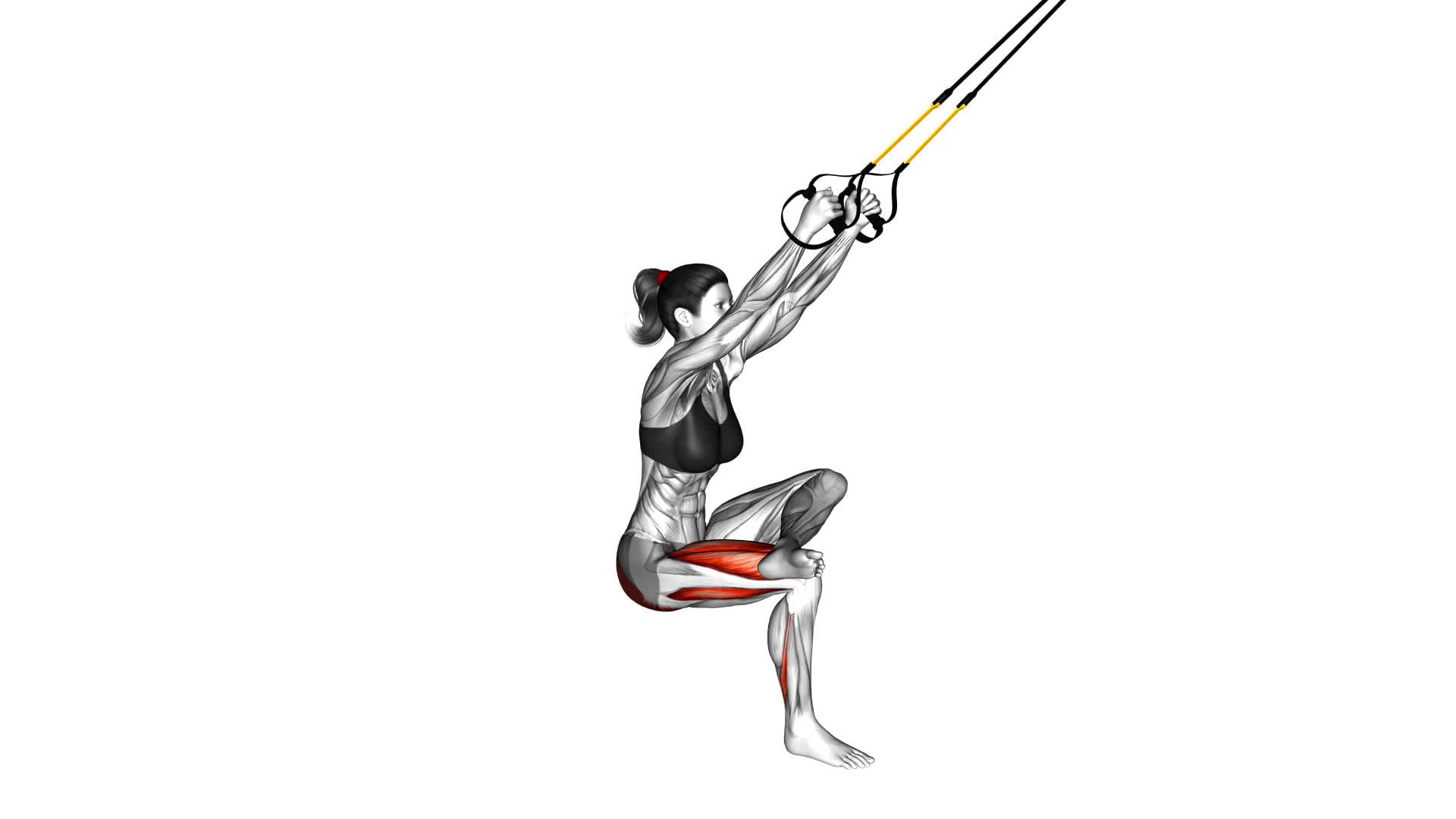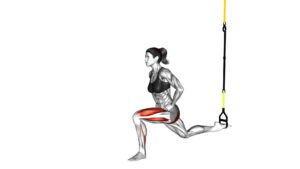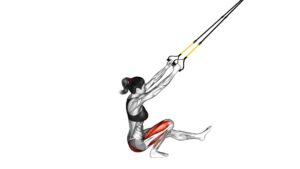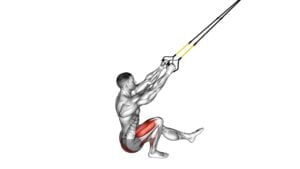Suspender Single Leg Squat (female) (figure) – Video Exercise Guide & Tips

Are you looking to strengthen your legs and improve your overall fitness?
Watch This Exercise Video
Check out this video exercise guide for the Suspender Single Leg Squat. This exercise targets your lower body, helping to tone and build muscle.
Learn how to properly set up for the exercise and execute it step-by-step. Avoid common mistakes and discover tips for increasing intensity and progression.
Whether you're a beginner or more advanced, this guide has safety precautions and modifications to suit your needs.
Let's get started!
Key Takeaways
- Targets specific muscles in the lower body (quadriceps, hamstrings, glutes)
- Improves balance and stability
- Enhances core strength
- Increases flexibility in the hips and ankles
Benefits of the Suspender Single Leg Squat
You can experience improved balance and strength with the Suspender Single Leg Squat. This exercise offers a range of benefits that can enhance your overall fitness routine.
One of the key advantages is that it targets specific muscles in your lower body, such as your quadriceps, hamstrings, and glutes. By engaging these muscles, you can develop greater strength and power, which can be beneficial for activities like running, jumping, and even everyday movements like walking and climbing stairs.
In addition to strength gains, the Suspender Single Leg Squat also helps improve your balance and stability. As you perform the exercise, you rely on your core muscles to maintain proper posture and control your body's movement. This not only enhances your balance but also strengthens your core muscles, which are essential for overall stability and preventing injuries.
Furthermore, the Suspender Single Leg Squat offers variations that allow you to challenge yourself as you progress. You can increase the difficulty by using heavier resistance bands or adding weights to the exercise. Alternatively, you can try different foot positions or incorporate balance tools like a stability ball or Bosu ball.
How to Properly Set Up for the Exercise
To set up for the Suspender Single Leg Squat, it's important to pay attention to your foot placement. Make sure your feet are shoulder-width apart and parallel to each other.
Additionally, adjust the height of the suspenders so that they're comfortably supporting your weight and allowing for proper range of motion.
Foot Placement Importance
To properly set up for the Suspender Single Leg Squat exercise, it's important to consider the placement of your feet. The alignment and positioning of your feet play a crucial role in performing this exercise correctly and effectively.
When starting, make sure your feet are hip-width apart, toes facing forward. This ensures proper alignment and stability throughout the movement.
As you progress, you can experiment with different foot positions to target different muscles and add variety to your workout. For example, a wider stance places more emphasis on your glutes, while a narrower stance targets your quadriceps.
Remember to adjust your foot placement according to your fitness level and goals.
Suspender Height Adjustment
Properly setting up the suspenders for the single leg squat exercise is crucial for effective execution. To ensure the right suspender height adjustment, start by checking the suspension system for any signs of wear or damage. Regular suspender maintenance is important to prevent accidents during the exercise.
Once you've confirmed that the suspenders are in good condition, adjust the height so that the handles are at a comfortable position for your grip. The suspenders should be securely attached to a stable anchor point. If you don't have access to suspenders, there are alternative exercises that can target similar muscle groups, such as lunges or step-ups.
Now that you understand the importance of proper suspender height adjustment, let's move on to the step-by-step guide for executing the squat.
Step-by-Step Guide for Executing the Squat
To execute the squat properly, it's important to focus on maintaining proper form throughout the movement. This includes:
- Keeping your back straight
- Keeping your chest up
- Aligning your knees with your toes
Avoid common mistakes such as:
- Rounding your back
- Letting your knees collapse inward
By performing the squat with correct form, you can reap the benefits of this exercise, such as:
- Strengthening your lower body muscles
- Improving your overall stability and balance.
Proper Form Demonstration
Start the squat by standing with your feet shoulder-width apart and your toes pointing slightly outward. To ensure proper form demonstration and provide tips for beginners, follow these steps:
- Engage your core muscles by pulling your belly button towards your spine.
- Slowly lower your body by bending your knees and pushing your hips back.
- Keep your chest lifted and your back straight throughout the movement.
- Lower yourself until your thighs are parallel to the ground, or as low as you can comfortably go.
Remember to breathe throughout the exercise and avoid rounding your back or letting your knees cave inwards.
It's important to start with a weight that challenges you but allows you to maintain proper form. As you gain strength and confidence, you can gradually increase the intensity of the squat.
Common Mistakes to Avoid
What are some common mistakes to avoid when executing the squat?
Proper technique is crucial when performing squats to maximize effectiveness and minimize the risk of injury. One common mistake isn't maintaining proper alignment of the knees and toes. To prevent this, make sure your knees are tracking in line with your toes throughout the movement.
Another mistake is going too deep or not deep enough. It's important to find the right range of motion that allows you to maintain proper form and engage the targeted muscles.
Additionally, rounding your back or arching excessively can put unnecessary strain on your spine. Focus on keeping your spine neutral throughout the squat.
Lastly, rushing through the exercise can compromise form. Take your time and perform each rep with control and intention.
Benefits of the Exercise
Maintain proper form and engage the targeted muscles by executing the squat with the suspender single leg squat exercise, which offers a variety of benefits. Here are four key benefits of incorporating this exercise into your routine:
- Increased lower body strength: The suspender single leg squat targets the muscles in your legs, including the quadriceps, hamstrings, and glutes. By performing this exercise regularly, you can strengthen these muscles, leading to improved stability and power.
- Improved balance and stability: Since the suspender single leg squat requires you to balance on one leg, it helps improve your overall balance and stability. This can be beneficial for various activities, such as sports, running, and everyday movements.
- Enhanced core strength: Maintaining proper form during the exercise requires engaging your core muscles. By doing so, you can strengthen your core, which is essential for maintaining good posture and preventing lower back pain.
- Functional movement training: The suspender single leg squat mimics movements we perform in our daily lives, such as climbing stairs or getting out of a chair. By incorporating this exercise into your routine, you can improve your ability to perform these movements with ease and reduce the risk of injury.
Common Mistakes to Avoid
To maximize the effectiveness of the Suspender Single Leg Squat, be mindful of the common mistakes to avoid while performing this exercise. Proper form is crucial to prevent injuries and achieve optimal results.
One common mistake is allowing your knee to cave inward during the squat. This can put excessive strain on your knee joint and lead to pain or injury. To correct this form, focus on pushing your knee outwards as you lower into the squat.
Another mistake to avoid is rounding your back. This not only reduces the effectiveness of the exercise but also puts strain on your spine. Keep your back straight and engage your core muscles throughout the movement.
It's also important to avoid using your non-working leg for assistance. This can take away the challenge from your target leg and make the exercise less effective. Instead, focus on using the strength of your working leg to perform the squat.
Tips for Increasing Intensity and Progression
To increase the intensity and progression of the Suspender Single Leg Squat, incorporate variations and add resistance to challenge your muscles further. Here are four tips to help you increase the difficulty of this exercise:
- Increase Resistance: You can use ankle weights or hold dumbbells in your hands to add resistance to the Suspender Single Leg Squat. This will make your muscles work harder and promote strength gains.
- Try Pistol Squats: Pistol squats are a more challenging variation of the Suspender Single Leg Squat. Instead of using the suspension trainer, you balance on one leg and lower yourself down into a squat position. This exercise engages your core and lower body muscles even more.
- Elevate Your Leg: Elevating your non-working leg on a step or bench will increase the range of motion and difficulty of the exercise. This will require greater stability and strength in your working leg.
- Use a Bosu Ball: Performing the Suspender Single Leg Squat on a Bosu ball adds an element of instability, which forces your muscles to work harder to maintain balance. This variation targets your core and leg muscles even more.
Safety Precautions and Modifications for Beginners
When starting the Suspender Single Leg Squat as a beginner, it's important to prioritize safety and make modifications to suit your fitness level. Safety modifications can help prevent injury and ensure a smooth progression in your fitness journey. Here are some beginner modifications to consider:
- Use a support: If you find it challenging to perform the exercise without losing balance, use a stable chair or wall for support. This will help you maintain proper form and stability.
- Reduce range of motion: Start by squatting to a comfortable depth that allows you to maintain good form. As you build strength and confidence, gradually increase the depth of your squat.
- Perform assisted squats: If the single leg squat is too challenging, you can start by performing the exercise with both feet on the ground. This will help you develop the necessary strength and stability before progressing to the single leg variation.
- Engage your core: Focus on activating your core muscles throughout the exercise. This will provide additional stability and support to your body.
Remember to listen to your body and take breaks as needed. It's important to gradually increase the intensity and difficulty of the exercise over time. By following these safety precautions and modifications, you can ensure a safe and effective workout experience as a beginner.
Frequently Asked Questions
What Are Some Alternative Exercises to the Suspender Single Leg Squat?
If you're looking for alternative exercises to the suspender single leg squat, there are a few options you can try.
One option is the Bulgarian split squat, which targets similar muscles and can be modified for beginners by using a lower step or platform.
Another alternative is the pistol squat, which challenges your balance and strength.
Remember to start with proper form and gradually increase difficulty as you progress.
Can This Exercise Be Performed by Individuals With Knee or Hip Injuries?
Yes, individuals with knee or hip injuries can modify the suspender single leg squat exercise. Instead, try alternative exercises that are easier on your joints, such as the seated leg press or the step-up exercise.
These exercises provide similar benefits without putting excessive strain on your knees or hips. Remember to consult with a healthcare professional or a certified trainer to ensure proper form and to adapt the exercises to your specific needs.
How Often Should the Suspender Single Leg Squat Be Incorporated Into a Workout Routine?
To properly incorporate the suspender single leg squat into your workout routine, it's recommended to perform it 2-3 times a week.
This exercise targets your leg muscles, improving strength and stability.
To ensure proper form and technique, start by standing upright with one foot in the suspender and the other foot off the ground.
Gradually lower your body into a squat position, keeping your back straight and knee aligned with your toes.
Repeat on the other leg for a balanced workout.
Are There Any Specific Muscle Groups That the Suspender Single Leg Squat Targets?
The suspender single leg squat is an exercise that targets multiple muscle groups, providing effective muscle activation. By focusing on a single leg, this exercise engages the quadriceps, hamstrings, glutes, and core muscles. Single leg exercises like this have various benefits. They can improve balance, stability, and unilateral strength. Incorporating the suspender single leg squat into your workout routine can help you develop overall lower body strength and enhance athletic performance.
Can the Suspender Single Leg Squat Be Performed Using Different Types of Equipment, Such as Resistance Bands or Dumbbells?
Yes, the suspender single leg squat can be performed using different types of equipment such as resistance bands or dumbbells.
Incorporating resistance bands into the exercise can add extra tension and challenge your muscles in different ways.
On the other hand, using dumbbells can increase the load on your muscles, making the exercise more intense.
Both options have their benefits, so choose the one that suits your fitness goals and preferences.
Conclusion
The suspender single leg squat is a challenging exercise that targets the lower body muscles and improves balance and stability. By following the proper setup and execution techniques, you can maximize the benefits of this exercise and avoid common mistakes.
Gradually increasing intensity and progression will help you continue to challenge your muscles. Beginners should take safety precautions and modify the exercise as needed.
Incorporating the suspender single leg squat into your workout routine can lead to stronger legs and improved overall fitness.

Author
Years ago, the spark of my life’s passion ignited in my mind the moment I stepped into the local gym for the first time. The inaugural bead of perspiration, the initial endeavor, the very first surge of endorphins, and a sense of pride that washed over me post-workout marked the beginning of my deep-seated interest in strength sports, fitness, and sports nutrition. This very curiosity blossomed rapidly into a profound fascination, propelling me to earn a Master’s degree in Physical Education from the Academy of Physical Education in Krakow, followed by a Sports Manager diploma from the Jagiellonian University. My journey of growth led me to gain more specialized qualifications, such as being a certified personal trainer with a focus on sports dietetics, a lifeguard, and an instructor for wellness and corrective gymnastics. Theoretical knowledge paired seamlessly with practical experience, reinforcing my belief that the transformation of individuals under my guidance was also a reflection of my personal growth. This belief holds true even today. Each day, I strive to push the boundaries and explore new realms. These realms gently elevate me to greater heights. The unique combination of passion for my field and the continuous quest for growth fuels my drive to break new ground.







